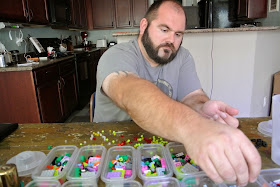LEGOS!
My friend went to a conference a few years ago where she learned about Legos being used in the classroom as non-linguistic representations. Loved that idea so much I decided to create my own set to use!
So the first step you need to do is go to the Lego store and get their $15 buckets and fill them to the brim with a variety of bricks. The thing about making your classroom set is that all of the tubs have to have the same exact Legos in them. That's why you can't just go to town on Craigslist and hope for the best. If your tubs aren't all the same, the kids will fight over that one container that has the wheels in it.
Stack your legos so that you can really cram 'em in!
Now that you have brought home a ridiculous amount of Legos, it is time to enlist your trusty husband or family member to help you sort through all of this nonsense...
You could use Legos for so much in the classroom and even though it is an investment (I spent around $65 for everything), you won't need to purchase them again. I used to use party favor sized Playdoh a lot for non-linguistic representations and still like to use them, but they dry out so quickly and the students are somewhat limited in what they can do.
Just be sure to write your name on the buckets in case you lend them out and number them that way you can hold your students accountable.
I plan to use these in a professional development coming up as well as in classrooms to model lessons. I can picture these being used to represent their understanding of a concept, definitions to vocabulary words, metaphors, fractions, probability, you name it!
What would you use Legos for in the classroom?












